ARIN3610 Essay: McLuhan, Google Maps, and Media Determinism
VerifiedAdded on 2022/12/27
|11
|2694
|78
Essay
AI Summary
This essay delves into Marshall McLuhan's theory of media determinism, examining how media, specifically Google Maps, restructures human experiences, activities, and associations. The essay analyzes the changes in scale, pace, and pattern introduced by Google Maps, illustrating its influence on travel, information access, and cultural heritage. It highlights how Google Maps enhances the scale of travel experiences, transforms travel patterns, and accelerates the pace of life by providing easy access to information. Furthermore, the essay acknowledges the role of Google Maps in preserving cultural heritage by encouraging tourism to various sites. The study also explores the limitations of McLuhan's media determinism, discussing criticisms related to its applicability across different societies and its oversimplification of societal impacts. The essay references McLuhan's concept of the medium as the message, and investigates how Google Maps alters human perceptions and behaviors. The analysis considers the technological and socio-economic factors that influence the theory's practical relevance, providing a comprehensive understanding of the subject. The essay draws on McLuhan's ideas and other scholarly sources to provide a well-rounded analysis.
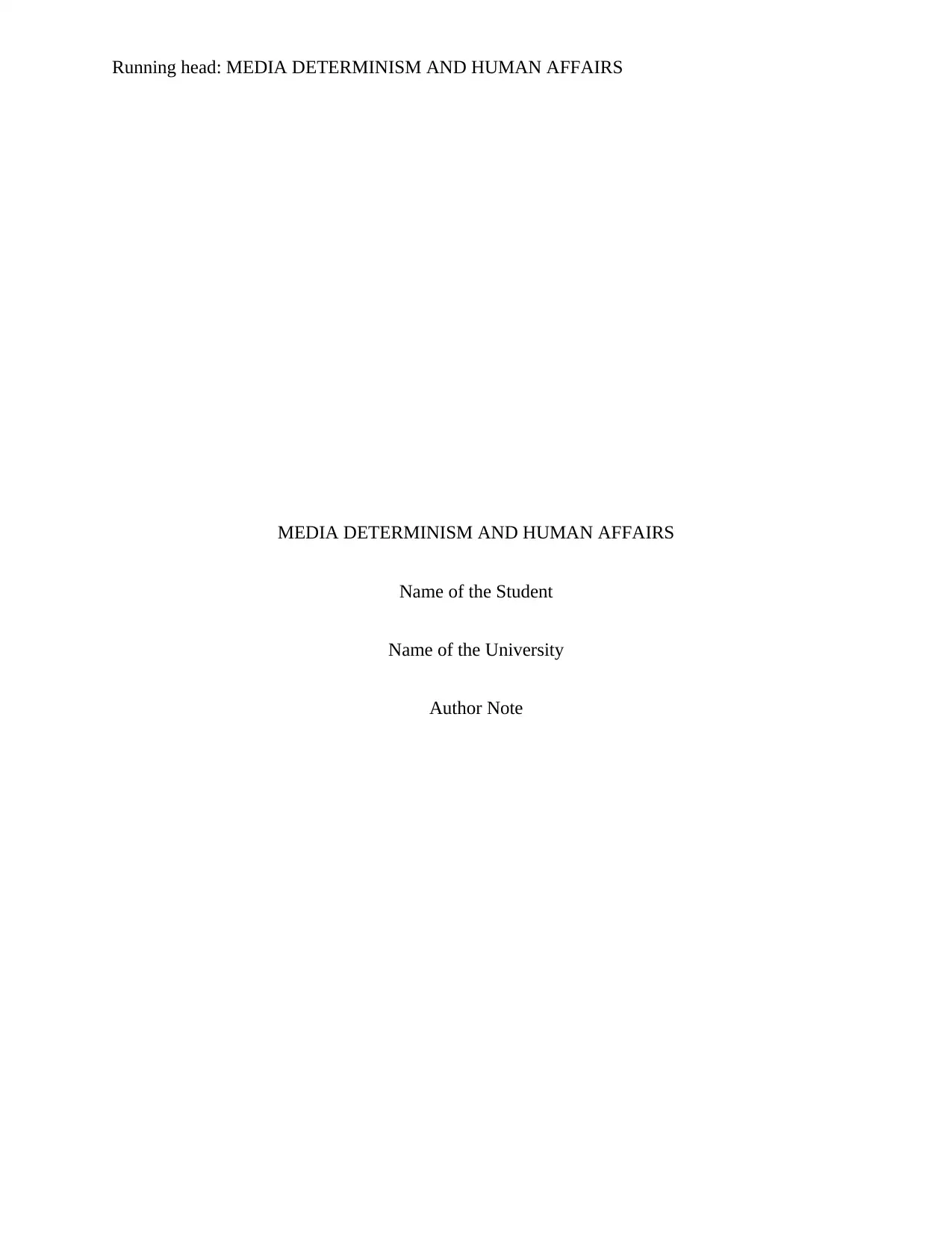
Running head: MEDIA DETERMINISM AND HUMAN AFFAIRS
MEDIA DETERMINISM AND HUMAN AFFAIRS
Name of the Student
Name of the University
Author Note
MEDIA DETERMINISM AND HUMAN AFFAIRS
Name of the Student
Name of the University
Author Note
Paraphrase This Document
Need a fresh take? Get an instant paraphrase of this document with our AI Paraphraser
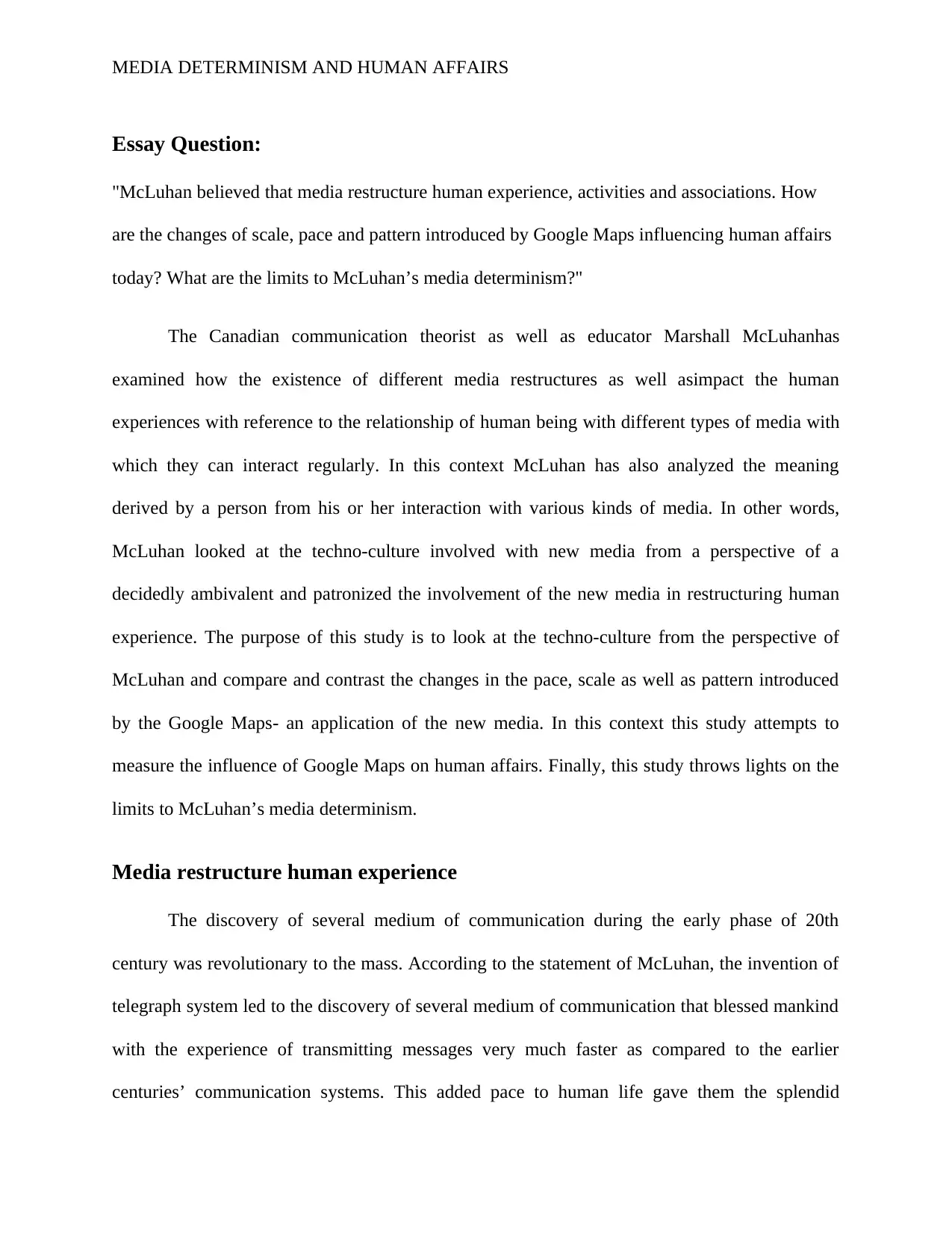
MEDIA DETERMINISM AND HUMAN AFFAIRS
Essay Question:
"McLuhan believed that media restructure human experience, activities and associations. How
are the changes of scale, pace and pattern introduced by Google Maps influencing human affairs
today? What are the limits to McLuhan’s media determinism?"
The Canadian communication theorist as well as educator Marshall McLuhanhas
examined how the existence of different media restructures as well asimpact the human
experiences with reference to the relationship of human being with different types of media with
which they can interact regularly. In this context McLuhan has also analyzed the meaning
derived by a person from his or her interaction with various kinds of media. In other words,
McLuhan looked at the techno-culture involved with new media from a perspective of a
decidedly ambivalent and patronized the involvement of the new media in restructuring human
experience. The purpose of this study is to look at the techno-culture from the perspective of
McLuhan and compare and contrast the changes in the pace, scale as well as pattern introduced
by the Google Maps- an application of the new media. In this context this study attempts to
measure the influence of Google Maps on human affairs. Finally, this study throws lights on the
limits to McLuhan’s media determinism.
Media restructure human experience
The discovery of several medium of communication during the early phase of 20th
century was revolutionary to the mass. According to the statement of McLuhan, the invention of
telegraph system led to the discovery of several medium of communication that blessed mankind
with the experience of transmitting messages very much faster as compared to the earlier
centuries’ communication systems. This added pace to human life gave them the splendid
Essay Question:
"McLuhan believed that media restructure human experience, activities and associations. How
are the changes of scale, pace and pattern introduced by Google Maps influencing human affairs
today? What are the limits to McLuhan’s media determinism?"
The Canadian communication theorist as well as educator Marshall McLuhanhas
examined how the existence of different media restructures as well asimpact the human
experiences with reference to the relationship of human being with different types of media with
which they can interact regularly. In this context McLuhan has also analyzed the meaning
derived by a person from his or her interaction with various kinds of media. In other words,
McLuhan looked at the techno-culture involved with new media from a perspective of a
decidedly ambivalent and patronized the involvement of the new media in restructuring human
experience. The purpose of this study is to look at the techno-culture from the perspective of
McLuhan and compare and contrast the changes in the pace, scale as well as pattern introduced
by the Google Maps- an application of the new media. In this context this study attempts to
measure the influence of Google Maps on human affairs. Finally, this study throws lights on the
limits to McLuhan’s media determinism.
Media restructure human experience
The discovery of several medium of communication during the early phase of 20th
century was revolutionary to the mass. According to the statement of McLuhan, the invention of
telegraph system led to the discovery of several medium of communication that blessed mankind
with the experience of transmitting messages very much faster as compared to the earlier
centuries’ communication systems. This added pace to human life gave them the splendid

MEDIA DETERMINISM AND HUMAN AFFAIRS
experience of transcending the obstacles like distance, congestion, in the path of communication
and make them feel that the world is a “a single planetary society” (Hannemyr.com, 2019).
According to McLuhan the role of media to restructure human experience is amplified
during the advent of internet in 1960s.The concept of “Intergalactic Computer Network”in 1963,
made the computers scientists realized the importance of a computer network and its practical
implication in the fields of defense as well as scientific researches (COMMONWEALTH OF
AUSTRALIA, 2019).. Research. Eventually ARPANET (Advanced Research Projects Agency
Network) came into existence and paved the way for what today’s internet. Observing the
changes in the human lives Marshall McLuhan argued that the application of this new
communication platform does not only change the way they communicate with each other, but
also bring pace in human lives which will foster radical transformation in human affairs
(Forbes.com, 2019). McLuhan considered that the pace induced by the electronic technology,
reshaped the thought process of humans. As internet or new media of communication expanded
its boundaries from research centers, defense towards the mass, the knowledge and perception as
well as attitude of the mass are restructured. The reconstruction and re-evaluation of ideas form
broader perception. Due to the active association of human beings with internet, social
interdependence increased (Kittler, 2010). The narrow un adaptable attitude of the society is
transformed into a broader outlook. The impact of the electronic media was persuasive (Kittler,
2010). The persuasive feature of the electronic media in the personal, political, economic,
aesthetic, psychological, moral, ethical, and social spheres, impacted, altered and restructured the
way of thinking of the world. Thus, the new media restructures human experience and fosters
assimilation of thoughts, culture and ethnicity (Venancio & Freitas, 2017).
experience of transcending the obstacles like distance, congestion, in the path of communication
and make them feel that the world is a “a single planetary society” (Hannemyr.com, 2019).
According to McLuhan the role of media to restructure human experience is amplified
during the advent of internet in 1960s.The concept of “Intergalactic Computer Network”in 1963,
made the computers scientists realized the importance of a computer network and its practical
implication in the fields of defense as well as scientific researches (COMMONWEALTH OF
AUSTRALIA, 2019).. Research. Eventually ARPANET (Advanced Research Projects Agency
Network) came into existence and paved the way for what today’s internet. Observing the
changes in the human lives Marshall McLuhan argued that the application of this new
communication platform does not only change the way they communicate with each other, but
also bring pace in human lives which will foster radical transformation in human affairs
(Forbes.com, 2019). McLuhan considered that the pace induced by the electronic technology,
reshaped the thought process of humans. As internet or new media of communication expanded
its boundaries from research centers, defense towards the mass, the knowledge and perception as
well as attitude of the mass are restructured. The reconstruction and re-evaluation of ideas form
broader perception. Due to the active association of human beings with internet, social
interdependence increased (Kittler, 2010). The narrow un adaptable attitude of the society is
transformed into a broader outlook. The impact of the electronic media was persuasive (Kittler,
2010). The persuasive feature of the electronic media in the personal, political, economic,
aesthetic, psychological, moral, ethical, and social spheres, impacted, altered and restructured the
way of thinking of the world. Thus, the new media restructures human experience and fosters
assimilation of thoughts, culture and ethnicity (Venancio & Freitas, 2017).
⊘ This is a preview!⊘
Do you want full access?
Subscribe today to unlock all pages.

Trusted by 1+ million students worldwide
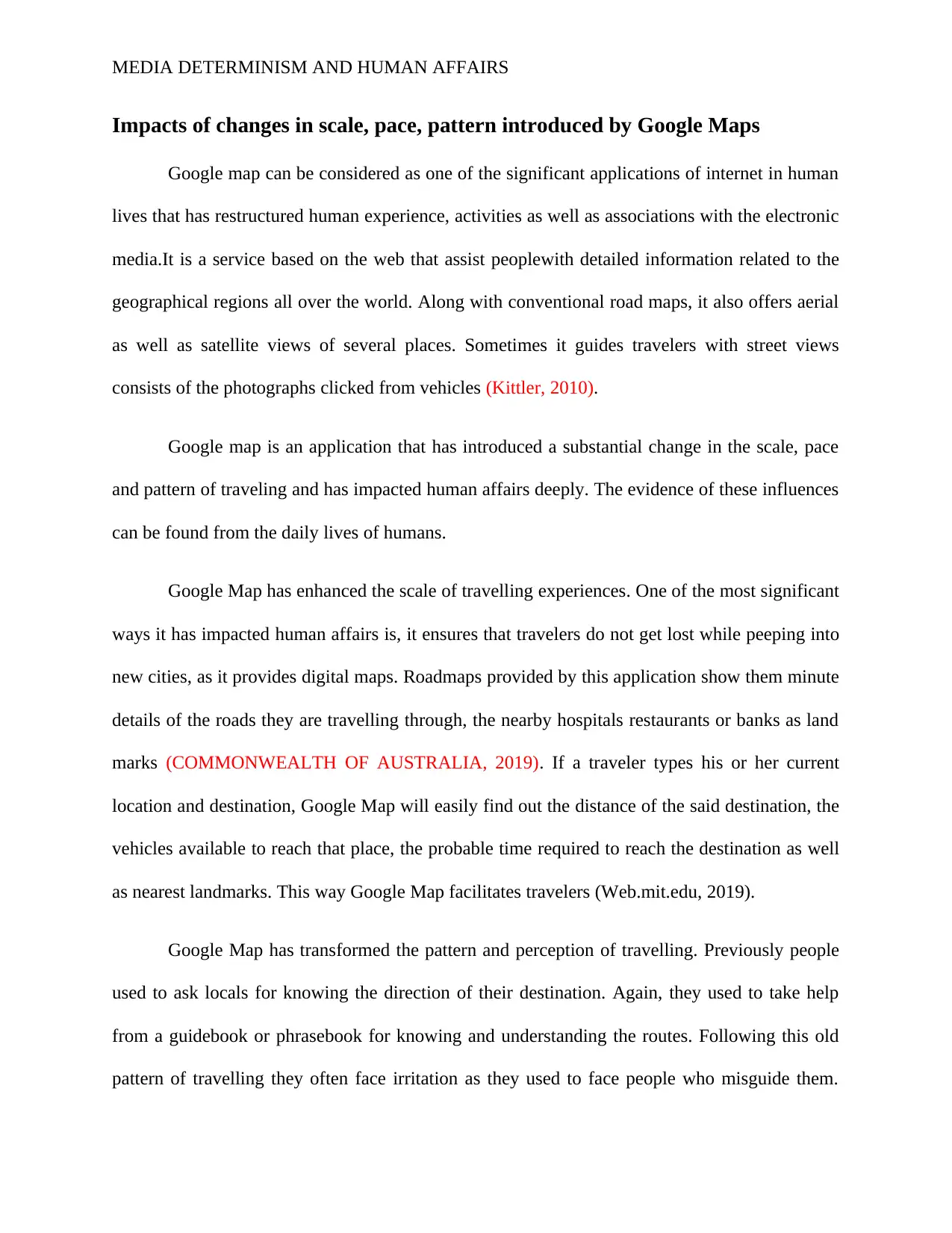
MEDIA DETERMINISM AND HUMAN AFFAIRS
Impacts of changes in scale, pace, pattern introduced by Google Maps
Google map can be considered as one of the significant applications of internet in human
lives that has restructured human experience, activities as well as associations with the electronic
media.It is a service based on the web that assist peoplewith detailed information related to the
geographical regions all over the world. Along with conventional road maps, it also offers aerial
as well as satellite views of several places. Sometimes it guides travelers with street views
consists of the photographs clicked from vehicles (Kittler, 2010).
Google map is an application that has introduced a substantial change in the scale, pace
and pattern of traveling and has impacted human affairs deeply. The evidence of these influences
can be found from the daily lives of humans.
Google Map has enhanced the scale of travelling experiences. One of the most significant
ways it has impacted human affairs is, it ensures that travelers do not get lost while peeping into
new cities, as it provides digital maps. Roadmaps provided by this application show them minute
details of the roads they are travelling through, the nearby hospitals restaurants or banks as land
marks (COMMONWEALTH OF AUSTRALIA, 2019). If a traveler types his or her current
location and destination, Google Map will easily find out the distance of the said destination, the
vehicles available to reach that place, the probable time required to reach the destination as well
as nearest landmarks. This way Google Map facilitates travelers (Web.mit.edu, 2019).
Google Map has transformed the pattern and perception of travelling. Previously people
used to ask locals for knowing the direction of their destination. Again, they used to take help
from a guidebook or phrasebook for knowing and understanding the routes. Following this old
pattern of travelling they often face irritation as they used to face people who misguide them.
Impacts of changes in scale, pace, pattern introduced by Google Maps
Google map can be considered as one of the significant applications of internet in human
lives that has restructured human experience, activities as well as associations with the electronic
media.It is a service based on the web that assist peoplewith detailed information related to the
geographical regions all over the world. Along with conventional road maps, it also offers aerial
as well as satellite views of several places. Sometimes it guides travelers with street views
consists of the photographs clicked from vehicles (Kittler, 2010).
Google map is an application that has introduced a substantial change in the scale, pace
and pattern of traveling and has impacted human affairs deeply. The evidence of these influences
can be found from the daily lives of humans.
Google Map has enhanced the scale of travelling experiences. One of the most significant
ways it has impacted human affairs is, it ensures that travelers do not get lost while peeping into
new cities, as it provides digital maps. Roadmaps provided by this application show them minute
details of the roads they are travelling through, the nearby hospitals restaurants or banks as land
marks (COMMONWEALTH OF AUSTRALIA, 2019). If a traveler types his or her current
location and destination, Google Map will easily find out the distance of the said destination, the
vehicles available to reach that place, the probable time required to reach the destination as well
as nearest landmarks. This way Google Map facilitates travelers (Web.mit.edu, 2019).
Google Map has transformed the pattern and perception of travelling. Previously people
used to ask locals for knowing the direction of their destination. Again, they used to take help
from a guidebook or phrasebook for knowing and understanding the routes. Following this old
pattern of travelling they often face irritation as they used to face people who misguide them.
Paraphrase This Document
Need a fresh take? Get an instant paraphrase of this document with our AI Paraphraser
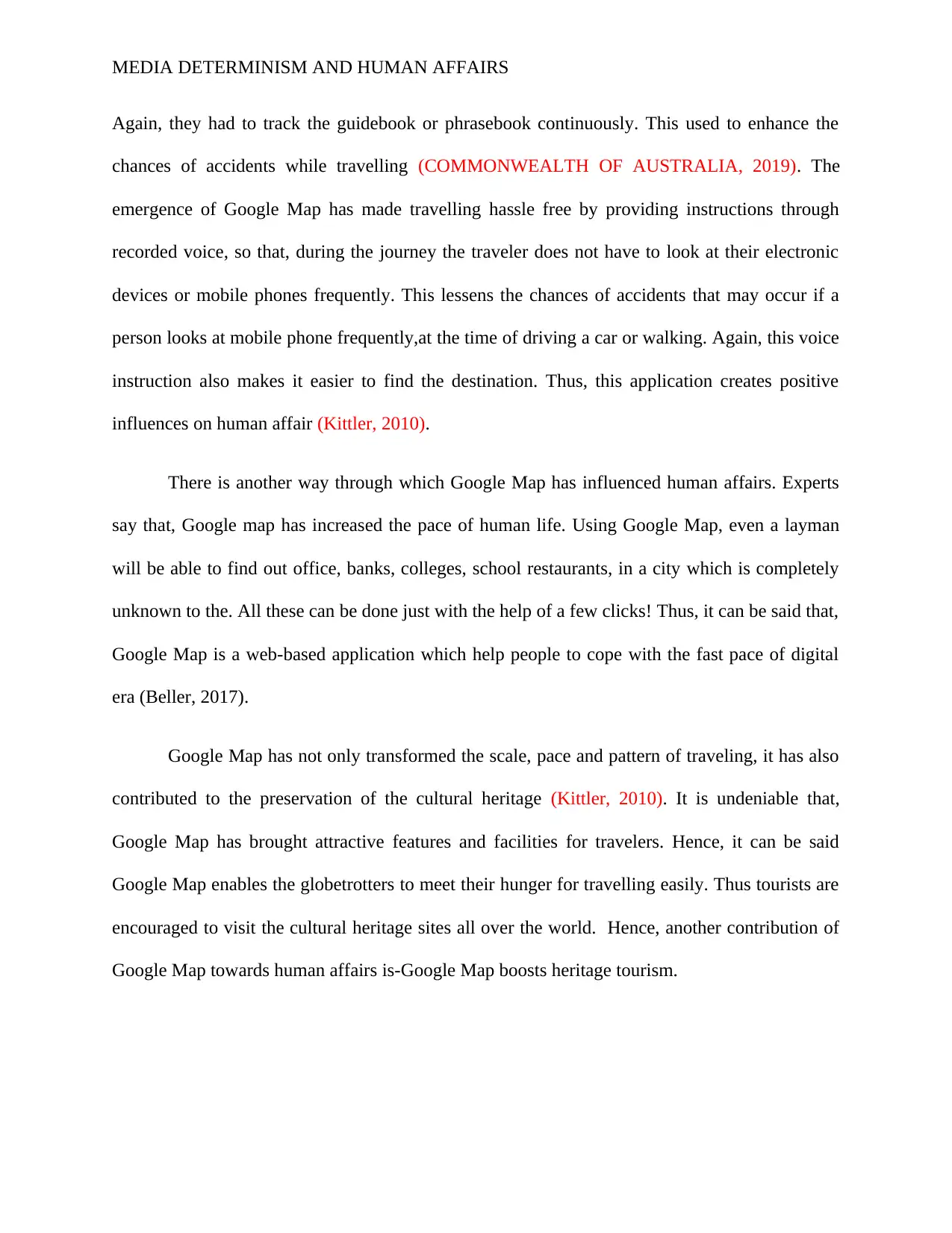
MEDIA DETERMINISM AND HUMAN AFFAIRS
Again, they had to track the guidebook or phrasebook continuously. This used to enhance the
chances of accidents while travelling (COMMONWEALTH OF AUSTRALIA, 2019). The
emergence of Google Map has made travelling hassle free by providing instructions through
recorded voice, so that, during the journey the traveler does not have to look at their electronic
devices or mobile phones frequently. This lessens the chances of accidents that may occur if a
person looks at mobile phone frequently,at the time of driving a car or walking. Again, this voice
instruction also makes it easier to find the destination. Thus, this application creates positive
influences on human affair (Kittler, 2010).
There is another way through which Google Map has influenced human affairs. Experts
say that, Google map has increased the pace of human life. Using Google Map, even a layman
will be able to find out office, banks, colleges, school restaurants, in a city which is completely
unknown to the. All these can be done just with the help of a few clicks! Thus, it can be said that,
Google Map is a web-based application which help people to cope with the fast pace of digital
era (Beller, 2017).
Google Map has not only transformed the scale, pace and pattern of traveling, it has also
contributed to the preservation of the cultural heritage (Kittler, 2010). It is undeniable that,
Google Map has brought attractive features and facilities for travelers. Hence, it can be said
Google Map enables the globetrotters to meet their hunger for travelling easily. Thus tourists are
encouraged to visit the cultural heritage sites all over the world. Hence, another contribution of
Google Map towards human affairs is-Google Map boosts heritage tourism.
Again, they had to track the guidebook or phrasebook continuously. This used to enhance the
chances of accidents while travelling (COMMONWEALTH OF AUSTRALIA, 2019). The
emergence of Google Map has made travelling hassle free by providing instructions through
recorded voice, so that, during the journey the traveler does not have to look at their electronic
devices or mobile phones frequently. This lessens the chances of accidents that may occur if a
person looks at mobile phone frequently,at the time of driving a car or walking. Again, this voice
instruction also makes it easier to find the destination. Thus, this application creates positive
influences on human affair (Kittler, 2010).
There is another way through which Google Map has influenced human affairs. Experts
say that, Google map has increased the pace of human life. Using Google Map, even a layman
will be able to find out office, banks, colleges, school restaurants, in a city which is completely
unknown to the. All these can be done just with the help of a few clicks! Thus, it can be said that,
Google Map is a web-based application which help people to cope with the fast pace of digital
era (Beller, 2017).
Google Map has not only transformed the scale, pace and pattern of traveling, it has also
contributed to the preservation of the cultural heritage (Kittler, 2010). It is undeniable that,
Google Map has brought attractive features and facilities for travelers. Hence, it can be said
Google Map enables the globetrotters to meet their hunger for travelling easily. Thus tourists are
encouraged to visit the cultural heritage sites all over the world. Hence, another contribution of
Google Map towards human affairs is-Google Map boosts heritage tourism.
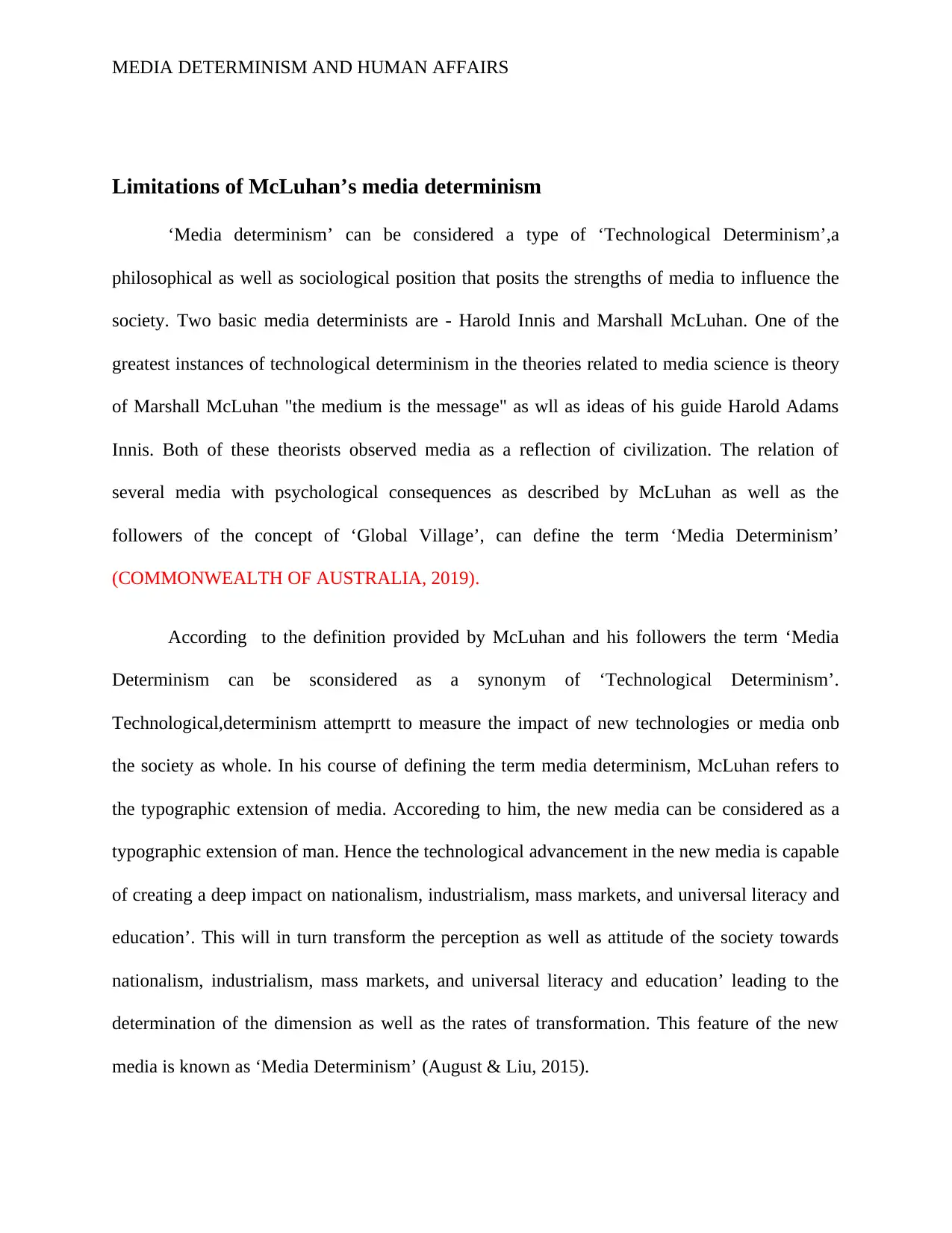
MEDIA DETERMINISM AND HUMAN AFFAIRS
Limitations of McLuhan’s media determinism
‘Media determinism’ can be considered a type of ‘Technological Determinism’,a
philosophical as well as sociological position that posits the strengths of media to influence the
society. Two basic media determinists are - Harold Innis and Marshall McLuhan. One of the
greatest instances of technological determinism in the theories related to media science is theory
of Marshall McLuhan "the medium is the message" as wll as ideas of his guide Harold Adams
Innis. Both of these theorists observed media as a reflection of civilization. The relation of
several media with psychological consequences as described by McLuhan as well as the
followers of the concept of ‘Global Village’, can define the term ‘Media Determinism’
(COMMONWEALTH OF AUSTRALIA, 2019).
According to the definition provided by McLuhan and his followers the term ‘Media
Determinism can be sconsidered as a synonym of ‘Technological Determinism’.
Technological,determinism attemprtt to measure the impact of new technologies or media onb
the society as whole. In his course of defining the term media determinism, McLuhan refers to
the typographic extension of media. Accoreding to him, the new media can be considered as a
typographic extension of man. Hence the technological advancement in the new media is capable
of creating a deep impact on nationalism, industrialism, mass markets, and universal literacy and
education’. This will in turn transform the perception as well as attitude of the society towards
nationalism, industrialism, mass markets, and universal literacy and education’ leading to the
determination of the dimension as well as the rates of transformation. This feature of the new
media is known as ‘Media Determinism’ (August & Liu, 2015).
Limitations of McLuhan’s media determinism
‘Media determinism’ can be considered a type of ‘Technological Determinism’,a
philosophical as well as sociological position that posits the strengths of media to influence the
society. Two basic media determinists are - Harold Innis and Marshall McLuhan. One of the
greatest instances of technological determinism in the theories related to media science is theory
of Marshall McLuhan "the medium is the message" as wll as ideas of his guide Harold Adams
Innis. Both of these theorists observed media as a reflection of civilization. The relation of
several media with psychological consequences as described by McLuhan as well as the
followers of the concept of ‘Global Village’, can define the term ‘Media Determinism’
(COMMONWEALTH OF AUSTRALIA, 2019).
According to the definition provided by McLuhan and his followers the term ‘Media
Determinism can be sconsidered as a synonym of ‘Technological Determinism’.
Technological,determinism attemprtt to measure the impact of new technologies or media onb
the society as whole. In his course of defining the term media determinism, McLuhan refers to
the typographic extension of media. Accoreding to him, the new media can be considered as a
typographic extension of man. Hence the technological advancement in the new media is capable
of creating a deep impact on nationalism, industrialism, mass markets, and universal literacy and
education’. This will in turn transform the perception as well as attitude of the society towards
nationalism, industrialism, mass markets, and universal literacy and education’ leading to the
determination of the dimension as well as the rates of transformation. This feature of the new
media is known as ‘Media Determinism’ (August & Liu, 2015).
⊘ This is a preview!⊘
Do you want full access?
Subscribe today to unlock all pages.

Trusted by 1+ million students worldwide
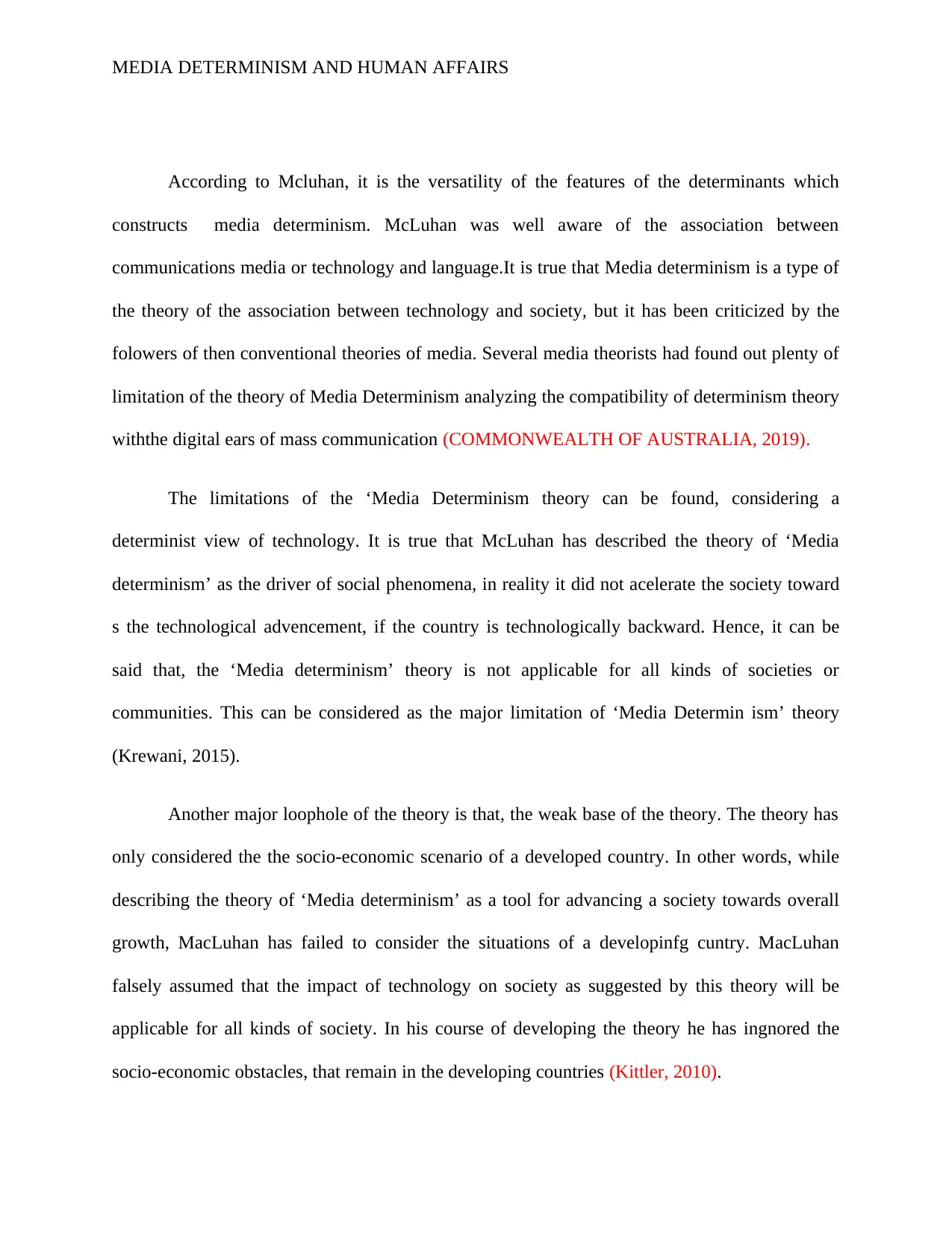
MEDIA DETERMINISM AND HUMAN AFFAIRS
According to Mcluhan, it is the versatility of the features of the determinants which
constructs media determinism. McLuhan was well aware of the association between
communications media or technology and language.It is true that Media determinism is a type of
the theory of the association between technology and society, but it has been criticized by the
folowers of then conventional theories of media. Several media theorists had found out plenty of
limitation of the theory of Media Determinism analyzing the compatibility of determinism theory
withthe digital ears of mass communication (COMMONWEALTH OF AUSTRALIA, 2019).
The limitations of the ‘Media Determinism theory can be found, considering a
determinist view of technology. It is true that McLuhan has described the theory of ‘Media
determinism’ as the driver of social phenomena, in reality it did not acelerate the society toward
s the technological advencement, if the country is technologically backward. Hence, it can be
said that, the ‘Media determinism’ theory is not applicable for all kinds of societies or
communities. This can be considered as the major limitation of ‘Media Determin ism’ theory
(Krewani, 2015).
Another major loophole of the theory is that, the weak base of the theory. The theory has
only considered the the socio-economic scenario of a developed country. In other words, while
describing the theory of ‘Media determinism’ as a tool for advancing a society towards overall
growth, MacLuhan has failed to consider the situations of a developinfg cuntry. MacLuhan
falsely assumed that the impact of technology on society as suggested by this theory will be
applicable for all kinds of society. In his course of developing the theory he has ingnored the
socio-economic obstacles, that remain in the developing countries (Kittler, 2010).
According to Mcluhan, it is the versatility of the features of the determinants which
constructs media determinism. McLuhan was well aware of the association between
communications media or technology and language.It is true that Media determinism is a type of
the theory of the association between technology and society, but it has been criticized by the
folowers of then conventional theories of media. Several media theorists had found out plenty of
limitation of the theory of Media Determinism analyzing the compatibility of determinism theory
withthe digital ears of mass communication (COMMONWEALTH OF AUSTRALIA, 2019).
The limitations of the ‘Media Determinism theory can be found, considering a
determinist view of technology. It is true that McLuhan has described the theory of ‘Media
determinism’ as the driver of social phenomena, in reality it did not acelerate the society toward
s the technological advencement, if the country is technologically backward. Hence, it can be
said that, the ‘Media determinism’ theory is not applicable for all kinds of societies or
communities. This can be considered as the major limitation of ‘Media Determin ism’ theory
(Krewani, 2015).
Another major loophole of the theory is that, the weak base of the theory. The theory has
only considered the the socio-economic scenario of a developed country. In other words, while
describing the theory of ‘Media determinism’ as a tool for advancing a society towards overall
growth, MacLuhan has failed to consider the situations of a developinfg cuntry. MacLuhan
falsely assumed that the impact of technology on society as suggested by this theory will be
applicable for all kinds of society. In his course of developing the theory he has ingnored the
socio-economic obstacles, that remain in the developing countries (Kittler, 2010).
Paraphrase This Document
Need a fresh take? Get an instant paraphrase of this document with our AI Paraphraser
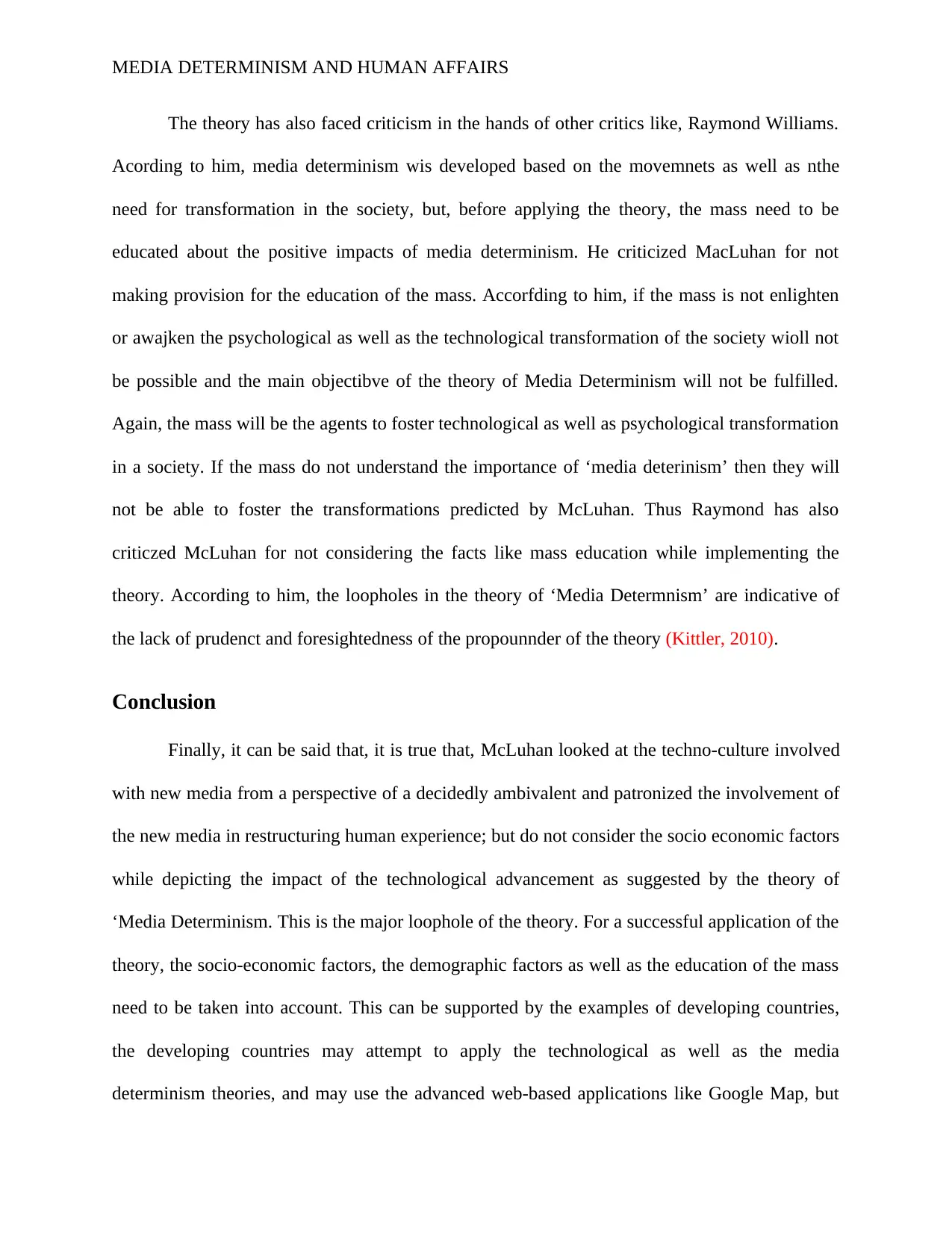
MEDIA DETERMINISM AND HUMAN AFFAIRS
The theory has also faced criticism in the hands of other critics like, Raymond Williams.
Acording to him, media determinism wis developed based on the movemnets as well as nthe
need for transformation in the society, but, before applying the theory, the mass need to be
educated about the positive impacts of media determinism. He criticized MacLuhan for not
making provision for the education of the mass. Accorfding to him, if the mass is not enlighten
or awajken the psychological as well as the technological transformation of the society wioll not
be possible and the main objectibve of the theory of Media Determinism will not be fulfilled.
Again, the mass will be the agents to foster technological as well as psychological transformation
in a society. If the mass do not understand the importance of ‘media deterinism’ then they will
not be able to foster the transformations predicted by McLuhan. Thus Raymond has also
criticzed McLuhan for not considering the facts like mass education while implementing the
theory. According to him, the loopholes in the theory of ‘Media Determnism’ are indicative of
the lack of prudenct and foresightedness of the propounnder of the theory (Kittler, 2010).
Conclusion
Finally, it can be said that, it is true that, McLuhan looked at the techno-culture involved
with new media from a perspective of a decidedly ambivalent and patronized the involvement of
the new media in restructuring human experience; but do not consider the socio economic factors
while depicting the impact of the technological advancement as suggested by the theory of
‘Media Determinism. This is the major loophole of the theory. For a successful application of the
theory, the socio-economic factors, the demographic factors as well as the education of the mass
need to be taken into account. This can be supported by the examples of developing countries,
the developing countries may attempt to apply the technological as well as the media
determinism theories, and may use the advanced web-based applications like Google Map, but
The theory has also faced criticism in the hands of other critics like, Raymond Williams.
Acording to him, media determinism wis developed based on the movemnets as well as nthe
need for transformation in the society, but, before applying the theory, the mass need to be
educated about the positive impacts of media determinism. He criticized MacLuhan for not
making provision for the education of the mass. Accorfding to him, if the mass is not enlighten
or awajken the psychological as well as the technological transformation of the society wioll not
be possible and the main objectibve of the theory of Media Determinism will not be fulfilled.
Again, the mass will be the agents to foster technological as well as psychological transformation
in a society. If the mass do not understand the importance of ‘media deterinism’ then they will
not be able to foster the transformations predicted by McLuhan. Thus Raymond has also
criticzed McLuhan for not considering the facts like mass education while implementing the
theory. According to him, the loopholes in the theory of ‘Media Determnism’ are indicative of
the lack of prudenct and foresightedness of the propounnder of the theory (Kittler, 2010).
Conclusion
Finally, it can be said that, it is true that, McLuhan looked at the techno-culture involved
with new media from a perspective of a decidedly ambivalent and patronized the involvement of
the new media in restructuring human experience; but do not consider the socio economic factors
while depicting the impact of the technological advancement as suggested by the theory of
‘Media Determinism. This is the major loophole of the theory. For a successful application of the
theory, the socio-economic factors, the demographic factors as well as the education of the mass
need to be taken into account. This can be supported by the examples of developing countries,
the developing countries may attempt to apply the technological as well as the media
determinism theories, and may use the advanced web-based applications like Google Map, but

MEDIA DETERMINISM AND HUMAN AFFAIRS
still the society as a whole will not be developed towards technological efficiency as suggested
by the theory of ‘Media Determinism’; if the mass is not educated and the socio –economic
condition of the society is not improved.
still the society as a whole will not be developed towards technological efficiency as suggested
by the theory of ‘Media Determinism’; if the mass is not educated and the socio –economic
condition of the society is not improved.
⊘ This is a preview!⊘
Do you want full access?
Subscribe today to unlock all pages.

Trusted by 1+ million students worldwide
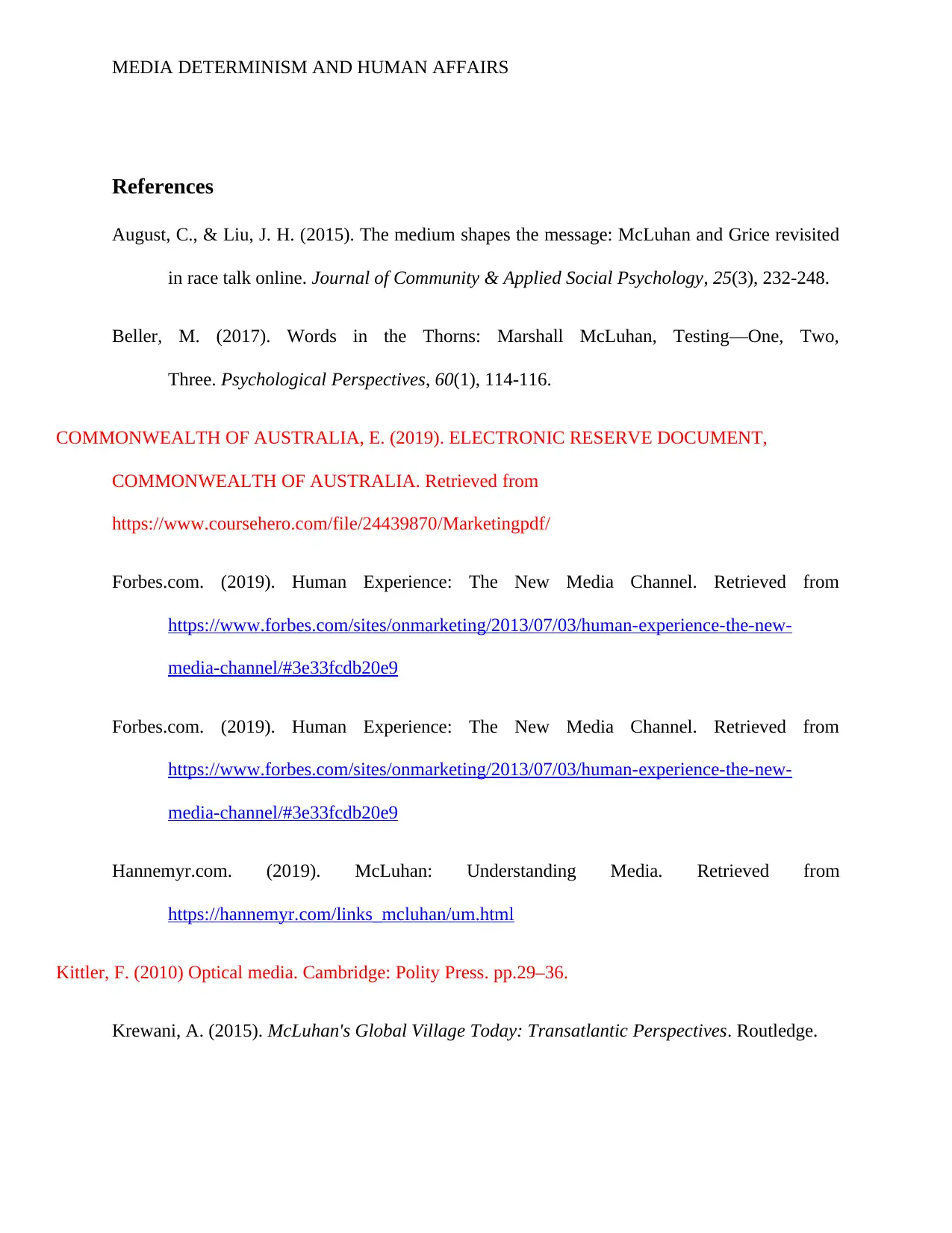
MEDIA DETERMINISM AND HUMAN AFFAIRS
References
August, C., & Liu, J. H. (2015). The medium shapes the message: McLuhan and Grice revisited
in race talk online. Journal of Community & Applied Social Psychology, 25(3), 232-248.
Beller, M. (2017). Words in the Thorns: Marshall McLuhan, Testing—One, Two,
Three. Psychological Perspectives, 60(1), 114-116.
COMMONWEALTH OF AUSTRALIA, E. (2019). ELECTRONIC RESERVE DOCUMENT,
COMMONWEALTH OF AUSTRALIA. Retrieved from
https://www.coursehero.com/file/24439870/Marketingpdf/
Forbes.com. (2019). Human Experience: The New Media Channel. Retrieved from
https://www.forbes.com/sites/onmarketing/2013/07/03/human-experience-the-new-
media-channel/#3e33fcdb20e9
Forbes.com. (2019). Human Experience: The New Media Channel. Retrieved from
https://www.forbes.com/sites/onmarketing/2013/07/03/human-experience-the-new-
media-channel/#3e33fcdb20e9
Hannemyr.com. (2019). McLuhan: Understanding Media. Retrieved from
https://hannemyr.com/links_mcluhan/um.html
Kittler, F. (2010) Optical media. Cambridge: Polity Press. pp.29–36.
Krewani, A. (2015). McLuhan's Global Village Today: Transatlantic Perspectives. Routledge.
References
August, C., & Liu, J. H. (2015). The medium shapes the message: McLuhan and Grice revisited
in race talk online. Journal of Community & Applied Social Psychology, 25(3), 232-248.
Beller, M. (2017). Words in the Thorns: Marshall McLuhan, Testing—One, Two,
Three. Psychological Perspectives, 60(1), 114-116.
COMMONWEALTH OF AUSTRALIA, E. (2019). ELECTRONIC RESERVE DOCUMENT,
COMMONWEALTH OF AUSTRALIA. Retrieved from
https://www.coursehero.com/file/24439870/Marketingpdf/
Forbes.com. (2019). Human Experience: The New Media Channel. Retrieved from
https://www.forbes.com/sites/onmarketing/2013/07/03/human-experience-the-new-
media-channel/#3e33fcdb20e9
Forbes.com. (2019). Human Experience: The New Media Channel. Retrieved from
https://www.forbes.com/sites/onmarketing/2013/07/03/human-experience-the-new-
media-channel/#3e33fcdb20e9
Hannemyr.com. (2019). McLuhan: Understanding Media. Retrieved from
https://hannemyr.com/links_mcluhan/um.html
Kittler, F. (2010) Optical media. Cambridge: Polity Press. pp.29–36.
Krewani, A. (2015). McLuhan's Global Village Today: Transatlantic Perspectives. Routledge.
Paraphrase This Document
Need a fresh take? Get an instant paraphrase of this document with our AI Paraphraser
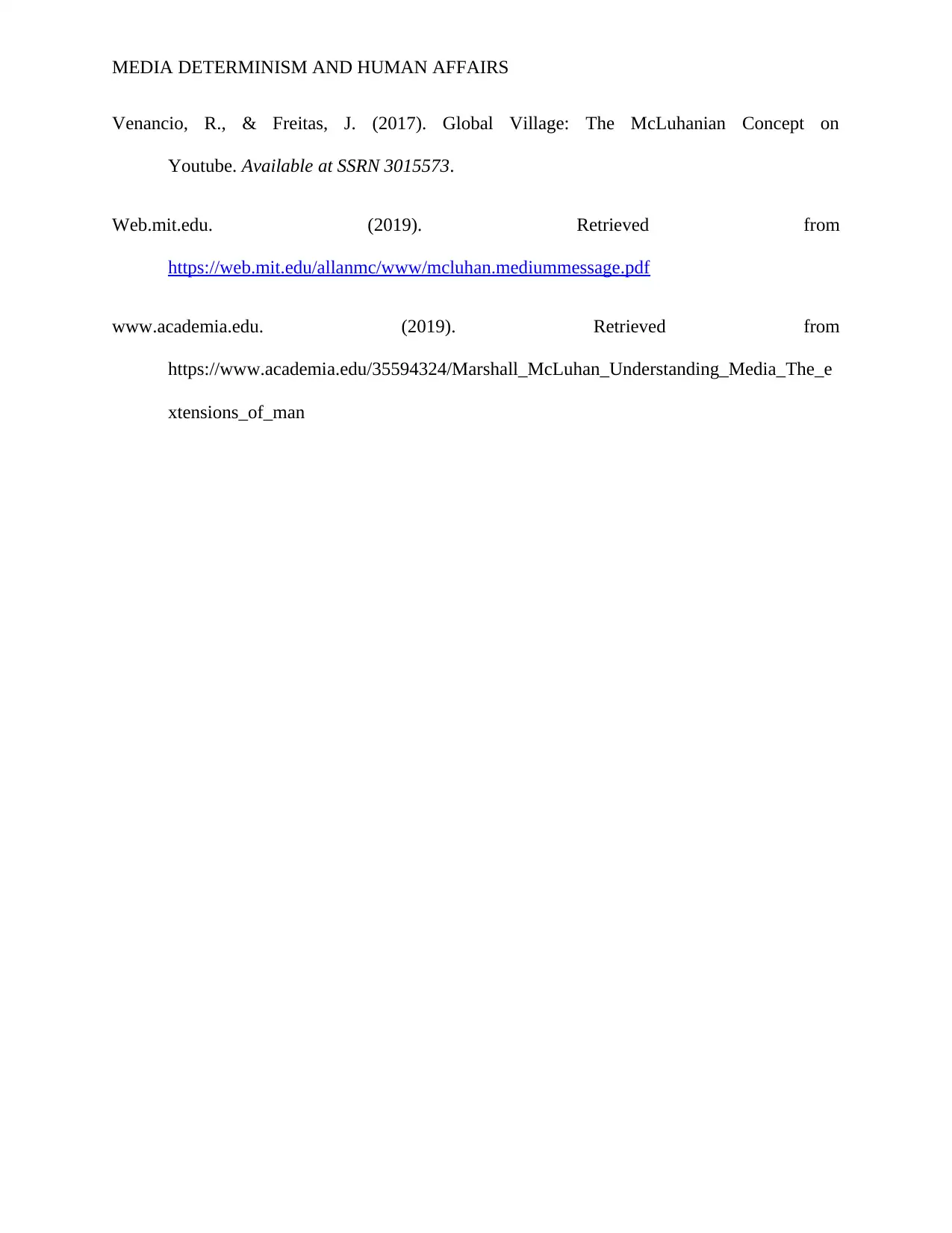
MEDIA DETERMINISM AND HUMAN AFFAIRS
Venancio, R., & Freitas, J. (2017). Global Village: The McLuhanian Concept on
Youtube. Available at SSRN 3015573.
Web.mit.edu. (2019). Retrieved from
https://web.mit.edu/allanmc/www/mcluhan.mediummessage.pdf
www.academia.edu. (2019). Retrieved from
https://www.academia.edu/35594324/Marshall_McLuhan_Understanding_Media_The_e
xtensions_of_man
Venancio, R., & Freitas, J. (2017). Global Village: The McLuhanian Concept on
Youtube. Available at SSRN 3015573.
Web.mit.edu. (2019). Retrieved from
https://web.mit.edu/allanmc/www/mcluhan.mediummessage.pdf
www.academia.edu. (2019). Retrieved from
https://www.academia.edu/35594324/Marshall_McLuhan_Understanding_Media_The_e
xtensions_of_man
1 out of 11
Related Documents
Your All-in-One AI-Powered Toolkit for Academic Success.
+13062052269
info@desklib.com
Available 24*7 on WhatsApp / Email
![[object Object]](/_next/static/media/star-bottom.7253800d.svg)
Unlock your academic potential
Copyright © 2020–2025 A2Z Services. All Rights Reserved. Developed and managed by ZUCOL.



